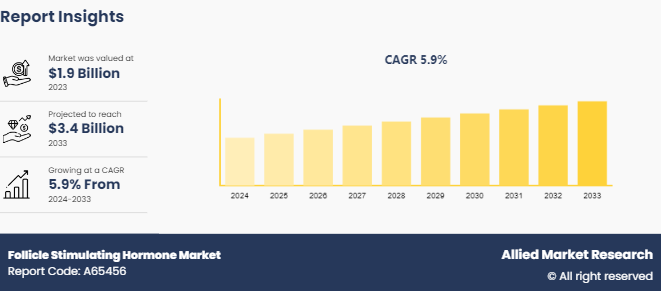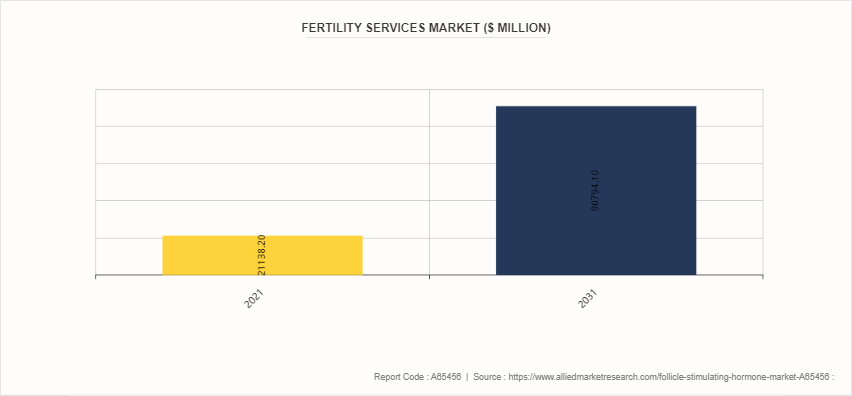Follicle Stimulating Hormone Market Research, 2033
The global follicle stimulating hormone market size was valued at $1.9 billion in 2023, and is projected to reach $3.4 billion by 2033, growing at a CAGR of 5.9% from 2024 to 2033. The follicle stimulating hormone market is majorly driven by the rise in infertility rate, increasing awareness about the advanced firtility treatment. Furthermore, the developing healthcare infrastructure such as firtility clinics is expected to drive the growth of the market.

Market Introduction and Definition
Follicle stimulating hormone (FSH) is a vital hormone central to reproductive health, primarily produced by the pituitary gland. In females, FSH plays a crucial role in the menstrual cycle and ovarian function by stimulating the growth and development of ovarian follicles, which contain the eggs. This hormone is pivotal in regulating the production of estrogen and progesterone, key hormones involved in the menstrual cycle and pregnancy. In males, FSH stimulates the production of sperm cells in the testes, working alongside luteinizing hormone (LH) to maintain fertility and normal reproductive function. FSH levels in both males and females fluctuate throughout the reproductive lifespan, with higher levels observed during puberty and lower levels during childhood and after menopause. Beyond its reproductive functions, FSH also influences bone health, and also plays a role in conditions like polycystic ovary syndrome (PCOS) and certain types of infertility.
Key Takeaways
- The follicle stimulating hormone market share study covers 20 countries. The research includes a segment analysis of each country in terms of value for the projected period
- More than 1, 500 product literatures, industry releases, annual reports, and other such documents of follicle stimulating hormone industry participants along with authentic industry journals, trade associations' releases, and government websites have been reviewed for generating high-value industry insights.
- The study integrated high-quality data, professional opinions and analysis, and critical independent perspectives. The research approach is intended to provide a balanced view of global markets and to assist stakeholders in making educated decisions to achieve their most ambitious growth objectives.
Key Market Dynamics
Key factors driving the follicle stimulating hormone market growth are increasing prevalence of infertility, technological innovations in follicle stimulating hormone products, and increasing awareness and acceptance. Globally, infertility rates are on the rise, influenced by various factors including lifestyle changes, environmental stressors, and delayed childbearing among others. According to 2023 article by Center of Disease Control and Prevention, 13.4% of women aged 15–49 were reported to suffer from impaired fecundity. As individuals and couples face difficulties conceiving naturally, there is a growing reliance on assisted reproductive technologies (ART) to fulfill their desire for parenthood. Thus, the growing prevalence of infirtility is expected to drive the growth of follicle stimulating hormone market size. Follicle stimulating hormone plays a crucial role in fertility treatments, as it is commonly used to stimulate ovulation in women undergoing procedures such as in vitro fertilization (IVF) or intracytoplasmic sperm injection (ICSI) , and to boost sperm production in men with fertility issues. Moreover, according to follicle stimulating hormone market opportunity analysis, societal trends such as later marriages and delayed childbearing contribute to the prevalence of age-related infertility, further fueling the demand for fertility treatments.
Parent Market Overview
The fertility services market being the parent market of the follicle stimulating hormone market encompasses a range of medical procedures, treatments, and technologies aimed at assisting individuals and couples in achieving pregnancy and overcoming infertility challenges. Globally, the market for fertility services has experienced significant growth in recent years, driven by several factors. Firstly, changing lifestyles, increasing stress levels, and delays in childbearing contribute to rising infertility rates, spurring demand for fertility treatments and assisted reproductive technologies (ART) . Further, growing awareness about fertility options, coupled with advancements in medical science and technology, have expanded the scope and accessibility of fertility services.

Market Segmentation
The follicle stimulating hormone industry is segmented into type, application, end user, and region. On the basis of type, the market is divided into recombinant FSH, and urinary FSH. On the basis of application, the market is classified into infertility treatment, assisted reproductive technology. As per end user, the market is segregated into hospitals, fertility clinics, and cryobanks. Region-wise, the market is analyzed across North America, Europe, Asia-Pacific, and LAMEA.
Regional/Country Market Outlook
According to follicle stimulating hormone market analysis, North America dominated the market share owing to robust demand for follicle stimulating hormone products, driven by factors such as delayed childbearing, increasing prevalence of infertility, and favorable reimbursement policies for assisted reproductive technologies (ART) . In addition, technological advancements and a strong presence of pharmaceutical companies specializing in fertility treatments contribute to market growth in these regions.
However, according to follicle stimulating hormone market forecast analysis emerging economies in Asia-Pacific, Latin America, and the Middle East and Africa (MEA) present unique opportunities and challenges for the follicle stimulating hormone market. While these regions may experience rapid population growth and rise in infertility rates due to factors such as urbanization, lifestyle changes, and environmental factors, access to fertility treatments and awareness about infertility may be comparatively lower. However, increasing healthcare spending, improving healthcare infrastructure, and a growing focus on reproductive health are expected to drive the adoption of fertility treatments, including FSH-based therapies, in these regions. Moreover, government initiatives aimed at expanding access to reproductive healthcare services and addressing infertility issues are likely to stimulate market growth in emerging economies.
- In an article published by Center of Disease Control and Prevention, it was reported that in 2024 8.5% of married women ages 15–49 (2.4 million) had infertility in the U.S.
- According to 2021 article by National Library of Medicine the mean of overall fertility awareness score in India was 50.2 ± 13.5
- In an article by the National Library of Medicine, it was reported that primary infertility in Africa was 49.91% in 2023.
Industry Trends
- According to the World Health Organization, it was reported that infertility affects around 1 in 6 adults worldwide.
- In September 2023, Center for Disease Control and Prevention released an article according to which about 238, 126 individuals underwent fertility treatment at 453 registered clinics leading to 91, 906 births.
- In October 2023, Australian Beuro of Statistics the birth rate decreased by 3% in 2023 as compared to 2021.
Competitive Landscape
The major players operating in the follicle stimulating hormone market include Pfizer Inc., Novartis AG, Abbott Laboratories, Sanofi S.A., Boehringer Ingelheim GmbH, Merck KGaA, Teva Pharmaceutical Industries Ltd., Zydus Lifesciences Limited, Intas Pharmaceuticals Ltd., and Cipla Ltd.
Other players in follicle stimulating hormone market includes Ferring Pharmaceuticals Inc., Lupin Limited, Livzon Pharmaceutical Group Inc., Emcure Pharmaceuticals Ltd., LG Chem's life sciences, and IBSA Group.
Recent Key Strategies and Developments
- In August 2021, Merck Speciality Pvt Ltd announced the launch of Pergoveris Pen. Pergoveris Pen is an innovative device that combines recombinant follicle stimulating hormone and recombinant luteinizing hormone (LH) in convenient prefill format.
- In August 2022, Myovant Sciences and Pfizer Inc. announced that the U.S. Food and Drug Administration (FDA) has approved Myfembree. It is once-a-day therapy for the management of moderate to severe pain associated with endometriosis in pre-menopausal women, with a treatment duration of up to 24 months
Key Sources Referred
- National Library of Medicine
- World Health Organization
- Ministry of Health, India
- Center of Disease Control and Prevention.
- American Society For Reproductive Medicine
- American Pregnancy Association
- American Embryo Transfer Association
Key Benefits for Stakeholders
- This report provides a quantitative analysis of the market segments, current trends, estimations, and dynamics of the follicle stimulating hormone market share analysis to identify the prevailing market opportunities.
- The market research is offered along with information related to key drivers, restraints, and opportunities.
- Porter's five forces analysis highlights the potency of buyers and suppliers to enable stakeholders make profit-oriented business decisions and strengthen their supplier-buyer network.
- In-depth analysis of the follicle stimulating hormone market segmentation assists to determine the prevailing market opportunities.
- Major countries in each region are mapped according to their revenue contribution to the global market.
- Market player positioning facilitates benchmarking and provides a clear understanding of the present position of the market players.
- The report includes the analysis of the regional as well as global follicle stimulating hormone market trends, key players, market segments, application areas, and market growth strategies.
Follicle Stimulating Hormone Market Report Highlights
| Aspects | Details |
| Market Size By 2033 | USD 3.4 Billion |
| Growth Rate | CAGR of 5.9% |
| Forecast period | 2024 - 2033 |
| Report Pages | 280 |
| By Type |
|
| By Application |
|
| By End User |
|
| By Region |
|
| Key Market Players | Zydus Lifesciences Limited, Sanofi S.A., Novartis AG, Pfizer Inc., Cipla Ltd., Abbott Laboratories, Merck KGaA, Boehringer Ingelheim GmbH, Teva Pharmaceutical Industries Ltd., Intas Pharmaceuticals Ltd. |
Analyst Review
The global follicle stimulating hormone (FSH) market is experiencing robust growth, driven by a combination of rising infertility rates, increased awareness of reproductive health, and advancements in biotechnology. With infertility affecting a significant portion of the global population, particularly in developed countries, the demand for effective fertility treatments is on the rise. The increasing prevalence of conditions such as polycystic ovary syndrome (PCOS) and other reproductive health disorders further propels the market. Additionally, technological advancements in recombinant DNA technology have led to the development of highly purified and efficient FSH products, enhancing treatment outcomes and patient satisfaction. Regulatory approvals for new FSH therapies and the expansion of healthcare infrastructure in emerging markets also contribute to market expansion
The forecast period for Follicle Stimulating Hormone Market is 2024-2033.
The total market value of Follicle Stimulating Hormone Market is $1.9 billion in 2023.
The market value of Follicle Stimulating Hormone Market is projected to reach $3.4 billion by 2033.
The base year is 2023 in Follicle Stimulating Hormone Market
Major key players that operate in the Follicle Stimulating Hormone Market are Pfizer Inc., Novartis AG, Abbott Laboratories, Sanofi S.A., Boehringer Ingelheim GmbH, Merck KGaA, and Teva Pharmaceutical Industries Ltd
Loading Table Of Content...


